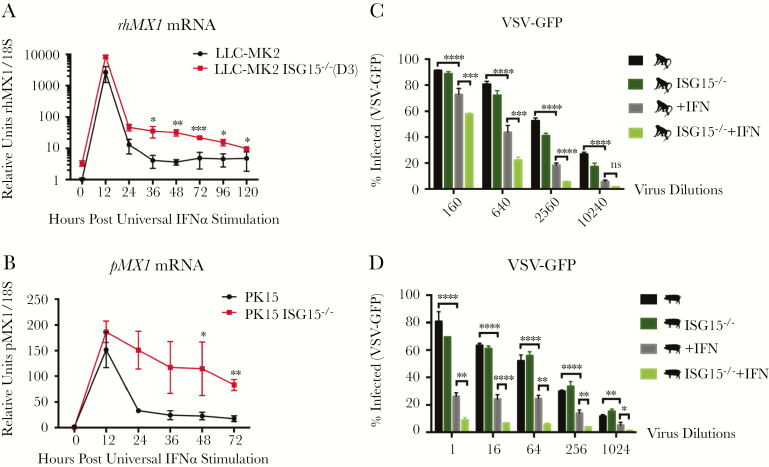Figure 2.
Interferon (IFN)-primed ISG15-knockout rhesus and porcine cells show persistent induction of IFN-stimulated gene (ISG) expression and enhanced resistance against vesicular stomatitis Indiana virus (VSV). (A and B) Interferon-stimulated gene expression of IFN-primed ISG15-deficient rhesus macaque and porcine cells. Wild-type and ISG15-knockout (KO) LLC-MK2 and PK-15 were stimulated with 100 U/mL universal IFN for 12 hours, washed with phosphate-buffered saline, and allowed to rest for various lengths of time. Relative messenger ribonucleic acid (mRNA) levels of rhesus macaque MX1 (rhMX1) (A) and porcine MX1 (pMX1) (B) were analyzed. (C and D) Vesicular stomatitis Indiana virus infection of rhesus macaque and porcine cells. Wild-type and ISG15-KO LLC-MK2 (D9 clone) (C) and PK-15 cells (D) before or after universal IFN treatment (100 U/mL; 12-hour stimulation followed by 36-hour rest) were infected with serial dilutions of recombinant VSV-green fluorescent protein (GFP). The cells were fixed 16 hours postinfection, stained with 4’,6-diamidino-2-phenylindole, imaged, and analyzed for percentage of nucleus-stained cells positive for GFP. Statistical comparison was performed with unpaired t tests for ISG expression analysis and with 2-way analysis of variance corrected with Šidák’s multiple comparison test for VSV infection analysis. A shows a representative experiment with biological triplicates of 3 different experiments performed. B shows a representative experiment with biological triplicates of 2 different experiments performed. C and D show a single experiment with biological triplicates. Error bars, standard deviation. *, P < .05; **, P < .01; ***, P < .001; ****, P < .0001.

